Monuments
- Details
- Category: Pictorial cycle showing the passages of St. Bridget's (Swedish) life
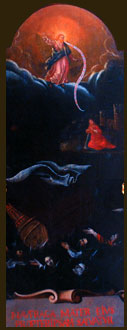 The first picture of the series presents an event in which Bridget's parents took part, even before her birth. This is a dramatic scene of a sinking ship and survivors during a sea storm. On the distant shore there is a kneeling pregnant Ingeborg – a mother of St. Bridget and over her, in the clouds Jesus Christ speaks with words: ECCE SALVATA ES PROPTER BONUM QVOD GESTAS IN VTERO TUO ('Here you are saved for the good that you carry in your womb'). Behind Ingeborga, we can see a castle that two flanking walls with bastions are crowned with battlements. The picture is signed with the words: NAVFRAGA MATER EIUS PROPTER IPSAM SALVATUR (Her mother being a shipwreck survivor is saved because of her).
The first picture of the series presents an event in which Bridget's parents took part, even before her birth. This is a dramatic scene of a sinking ship and survivors during a sea storm. On the distant shore there is a kneeling pregnant Ingeborg – a mother of St. Bridget and over her, in the clouds Jesus Christ speaks with words: ECCE SALVATA ES PROPTER BONUM QVOD GESTAS IN VTERO TUO ('Here you are saved for the good that you carry in your womb'). Behind Ingeborga, we can see a castle that two flanking walls with bastions are crowned with battlements. The picture is signed with the words: NAVFRAGA MATER EIUS PROPTER IPSAM SALVATUR (Her mother being a shipwreck survivor is saved because of her).
Bridget's parents were devout, charitable, willing pilgrims to holy places. When before the St. Bridget's birth they were returning from Kildare in Ireland they found themselves in great danger due to the sea storm. Ingeborga was miraculously saved from that danger. During dreaming the next night, like in reality, she saw a glowing figure who told her: You are saved for the good that you have here in life, so raise it with God's love, because it is God's gift to you.
In this image two simultaneous events are showed, which have taken place at different times. Both however are emphasizing that it was a divine intention, for St. Bridget to accomplish her mission on earth.
- Details
- Category: Pictorial cycle showing the passages of St. Bridget's (Swedish) life
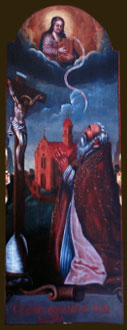 The next scene of the cycle does not yet reveal the Saint herself, though it happens after her birth. In the foreground we can see a bishop, an elderly man kneeling in deep prayer. This is Benedict, a parish priest of Rasbo, who on 14 June was praying that Ingeborga would happily give birth to her baby. In heavens where he is directing his gaze, he sees Mary with a book in her hand speaking to him: NATA EST BIRGERO FILIA, CUIUS VOX ADMIRABILIS AUDIETUR PER ORBEM ('A daughter was born to Birger, her voice will be heard in the whole world').
The next scene of the cycle does not yet reveal the Saint herself, though it happens after her birth. In the foreground we can see a bishop, an elderly man kneeling in deep prayer. This is Benedict, a parish priest of Rasbo, who on 14 June was praying that Ingeborga would happily give birth to her baby. In heavens where he is directing his gaze, he sees Mary with a book in her hand speaking to him: NATA EST BIRGERO FILIA, CUIUS VOX ADMIRABILIS AUDIETUR PER ORBEM ('A daughter was born to Birger, her voice will be heard in the whole world').
The painting is also signed with the words: CAELITUS ANUNTIATUR NATAE GLORIA (The glory of the born is announced from heaven). When Bridget was to be born the guardian of the nearby church, who in the future became the Aibona bishop, had a wonderful vision. Praying at the time of her birth, a cloud appeared to him, and in the cloud he saw Mary holding a book in her hand. Then she told him that a daughter was just born to Birger and she would preach the joy of salvation.
This scene is set against the landscape with a clearly marked silhouette of the church. This church has a very characteristic stepped finished top of the facade with pinnacles sticking out beyond the plain. The top is decorated with three rows of blends separated from each other by stretches of ledges. The facade has an entrance portal, above which there is a tracery window. The iconographic comparisons show that this is a church of the Bridgettines in Lublin before going up a tower to the church's building body.
- Details
- Category: Pictorial cycle showing the passages of St. Bridget's (Swedish) life
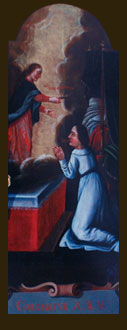 The event took place when Bridget was a seven-year-old girl. The picture shows an inscription: CORONATUR A B [EATA] V [IRGINE] (She is crowned by the B[lessed] V[irgin] Mary). We see her keeping guard on the prayer. A bed in the background and St. Bridget in a nightly dress kneeling before something called an altar stone, as witnessed about the time of a day. In the picture we can see the Virgin Mary standing in the clouds speaking to her with words: VIS NE HABERE ISTAM CORONAM ('Do you want to have this crown?') and passes to the Saint's direction a crown with seven multicoloured jewels in it. Bridget answers VOLO ('I want'). On the painting this text is shown in a mirror image. Acceptance, even zeal, is reflected both in prayer and on her face. It was the first revelation of St. Bridget, which she revealed to her confessor in Rome at the end of her life. She told him that the Virgin Mary had appeared with a precious crown in her hand, decorated with seven precious jewels. Mary asked her if she wanted to receive it. When Bridget agreed, the Mother of God put it on the visionary's head.
The event took place when Bridget was a seven-year-old girl. The picture shows an inscription: CORONATUR A B [EATA] V [IRGINE] (She is crowned by the B[lessed] V[irgin] Mary). We see her keeping guard on the prayer. A bed in the background and St. Bridget in a nightly dress kneeling before something called an altar stone, as witnessed about the time of a day. In the picture we can see the Virgin Mary standing in the clouds speaking to her with words: VIS NE HABERE ISTAM CORONAM ('Do you want to have this crown?') and passes to the Saint's direction a crown with seven multicoloured jewels in it. Bridget answers VOLO ('I want'). On the painting this text is shown in a mirror image. Acceptance, even zeal, is reflected both in prayer and on her face. It was the first revelation of St. Bridget, which she revealed to her confessor in Rome at the end of her life. She told him that the Virgin Mary had appeared with a precious crown in her hand, decorated with seven precious jewels. Mary asked her if she wanted to receive it. When Bridget agreed, the Mother of God put it on the visionary's head.
At the end of her life, when she was seriously ill, she had another vision. St. Agnes visited her and explained her the meaning of this crown and the symbolism of the expensive stones that it was decorated. The stones has signified the nuisance of life, which are primarily caused by other people. But they are to be better and more aware of holiness. Jasper was set by the one who spoke of her abusive things. Sapphire set the one who used to say favourable words to her and behind eyes backbited her. Emerald however the one who said these things about which she did not think, or did not say. The pearl set in the crown who criticised religious men in her presence and the topaz was symbolized by person who spoke sarcastic words, while Bridget blessed him. The diamond set the one who made her body harm, and the last jewel-ruby put a slanderer.
- Details
- Category: Pictorial cycle showing the passages of St. Bridget's (Swedish) life
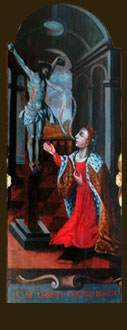 This is Bridget's next vision. She had it when she was ten. The image was signed with the words: CUM CHRISTO CRUCIFIXO LOQVITUR (She is talking to the Crucified Christ).
This is Bridget's next vision. She had it when she was ten. The image was signed with the words: CUM CHRISTO CRUCIFIXO LOQVITUR (She is talking to the Crucified Christ).
The Saint is kneeling before the Crucified Christ. From the mouth of St. Bridgit some words are uttered: DOMINE, QVIS FECIT TIBI ISTUD ('Lord, who did it to You'? - a mirror inscription), Christ answers: QVI ME CONTEMNUNT ('Those who despise me'). This vision happened at night, after she heard a sermon about the Passion of the Saviour in the church. She saw the Christ as if crucified and complaining: 'I am so scourged'. What she understood as if it had just happened and she replied: 'O, Lord! Who did it to You? Christ answered: 'Those who despise me and do not care for my love do it to me'.
This event has significant influence on the Passion piety of St. Bridget, which will become the main theme of her spiritual reflections. In her ecstatic states, the Saint saw and experienced the crucifixion of Jesus twice more. The discussed image depicts the first such vision. The scene is set in the church: the dark background of the interior is brightened by the light coming out of the big window, which closes the perspective of the composition. As in one of the earlier images, these two events which took place in different times, were portrayed together.
In this painting Bridget was portrayed in a rich attire: in an ermine coat and in sophisticated hairstyle. In this way the artist wanted to emphasize her high social origins, and by contrast with next paintings, where Bridget was dressed in a monastic habit, wanted to point to the two stages of her life: the first when she led a secular life and the second when she lived as a nun.
- Details
- Category: Pictorial cycle showing the passages of St. Bridget's (Swedish) life
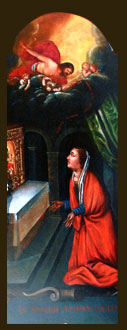 This is the last scene in which the Saint is presented in the rich attire of a lay person and again during one of her revelations. The painting is signed: IN SPONSAM A CHRISTO ELIGITUR (Chosen by Christ for a bride). Bridget is in the church, the arcades in the background proclaim it. She is kneeling at the altarpiece depicting Mary with Child. During her prayer Jesus appeared to her directing the following words that are written in the picture on the banderole: TU ERIS MEA, VIDEBIS SECRET CELESTIA ('You will be my bride and you will see heaven's mysteries').
This is the last scene in which the Saint is presented in the rich attire of a lay person and again during one of her revelations. The painting is signed: IN SPONSAM A CHRISTO ELIGITUR (Chosen by Christ for a bride). Bridget is in the church, the arcades in the background proclaim it. She is kneeling at the altarpiece depicting Mary with Child. During her prayer Jesus appeared to her directing the following words that are written in the picture on the banderole: TU ERIS MEA, VIDEBIS SECRET CELESTIA ('You will be my bride and you will see heaven's mysteries').
Christ's figure shot here is interesting. He is shown in a dynamic pose, the right hand rejecting as if to indicate its direction, while the left indicates the beginning of the banderole, which ends at the height of Bridget's eye. Whereas she is spreading her arms helplessly, surprised looking at Christ.
In this image we can see one of many revelations (since 1346), which Bridget received in the Cistercian monastery in Alwastra, where she joined after the death of her husband. Previously she settled the property matters. She shared out her goods among heirs and the poor. This image shows an important moment in her life when the Saint decides to give up her secular life. Then he finds in the person of Peter Olafson a spiritual guide and a secretary. He and father Peter of Skanninge, translated the visions of Bridget's written in Swedish into Latin.
- Details
- Category: Pictorial cycle showing the passages of St. Bridget's (Swedish) life
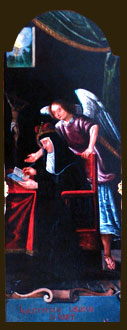 The picture was signed: INSTITUTUM ORDINI SCRIBIT (is writing the Rule for the Order). This is the first image on which we see the Saint dressed in the habit of the Bridgettine's Order. To the end of the cycle she will be shown in this way. In fact, she never wore the dress of the established order. In tradition, however, it is adopted presenting her in the abbess's habit.
The picture was signed: INSTITUTUM ORDINI SCRIBIT (is writing the Rule for the Order). This is the first image on which we see the Saint dressed in the habit of the Bridgettine's Order. To the end of the cycle she will be shown in this way. In fact, she never wore the dress of the established order. In tradition, however, it is adopted presenting her in the abbess's habit.
St. Bridget's life was divided into two stages: secular in Sweden, when she was a wife and mother, and life in Rome after her husband's death. The second stage resembled the rhythm of monastic life: common prayers, meals, studies, penitential practices, pilgrimages, visiting churches for gaining indulgences.
In this image, a crucifix is standing on the table next to the Saint. Bridget is writing the words given to her by an angel who is bending over her behind the back of her chair. In the upper left corner of the picture we see a window through which light rays are emerging behind heavy clouds. They are falling down on the centre of the room. This is a divine sign of the custody of the newly established order.
Bridget received a commending to establish a new Order. It was in the spring of 1346, during a mystical rapture when she received a revelation concerning organization of the Order. The Rule of the Order of the Most Holy Saviour wrote in the monastery in Alwastra, Sweden. She went to Rome at the end of 1349 for approving it by the Pope.
- Details
- Category: Pictorial cycle showing the passages of St. Bridget's (Swedish) life
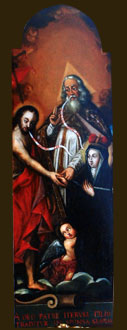 This painting is signed with the words: A DEO PATRE ITERVM FIL[IO] TRADITUR IN SPONSA GLO[RIAE] ( God the Fathe is passing on (Bridget) to the Son as a bride of glory). The Saviour is giving his hand to the kneeling Saint. God the Father is standing behind them, who blessing is saying these words: SPONSAM ASIGNO TIBI ('I give You the Bride'). Christ responds: EGO ASSUMO EAM ('I accept Her'). Bridget is portreying here as a nun, but on her head she has a royal mitre with a cross. Divine persons have differen halos: God the Father has it in the form of a triangle, Christ in the shape of a luminescent rim.
This painting is signed with the words: A DEO PATRE ITERVM FIL[IO] TRADITUR IN SPONSA GLO[RIAE] ( God the Fathe is passing on (Bridget) to the Son as a bride of glory). The Saviour is giving his hand to the kneeling Saint. God the Father is standing behind them, who blessing is saying these words: SPONSAM ASIGNO TIBI ('I give You the Bride'). Christ responds: EGO ASSUMO EAM ('I accept Her'). Bridget is portreying here as a nun, but on her head she has a royal mitre with a cross. Divine persons have differen halos: God the Father has it in the form of a triangle, Christ in the shape of a luminescent rim.
In her Revelations, Bridget does not say anything about spiritual marriage with God. Although she is named wedded, but it may mean she has been redeemed by the blood of Jesus Christ and that she led life in the sanctifying grace. We can not even speak of religious consecration by which the person who makes such vows is married to Christ. Bridget never made a monastic profession, although she always desired religious life with all its spiritual effects. In the picture, however, the moment of marriage in the sense of entrusting is clearly shown. God the Father gives Bridget to Christ.
- Details
- Category: Pictorial cycle showing the passages of St. Bridget's (Swedish) life
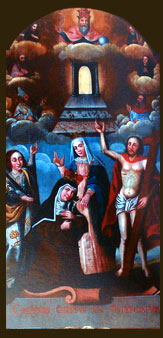 The painting is signed by: CAELESTIS CELITUS ILLI OSTENDATUR (God is appearing her from heaven). Bridget is wearing a dress of her order, but also with the prince's mitre on her head is kneeling humbly bowed embracing the cross. Next to her the Christ is standind as the Salvator, Mary in the crown on Her head, and St. Agnes, shown here with her attribute - a lamb and a palm of martyrdom. Behind this group in the background you can see heaven, in the middle of which there is a gate in a shining rim. Three stairs lead to it.
The painting is signed by: CAELESTIS CELITUS ILLI OSTENDATUR (God is appearing her from heaven). Bridget is wearing a dress of her order, but also with the prince's mitre on her head is kneeling humbly bowed embracing the cross. Next to her the Christ is standind as the Salvator, Mary in the crown on Her head, and St. Agnes, shown here with her attribute - a lamb and a palm of martyrdom. Behind this group in the background you can see heaven, in the middle of which there is a gate in a shining rim. Three stairs lead to it.
Above the gate we can see a figure of God the Father in the papal tiara on His head. On both sides the saints in the clouds: St. Paul - with a sword, John the Evangelist - with an eagle. The two highest placed half-length saints, as a result of cutting the image while matching it to the new stalls, are now deprived of their attributes. However, they are presented in an iconographic tradition. You can recognize John the Baptist in the robe of the hermit and St. Peter, who is shown as a gray old man with a short, curly beard. The pair of the lowest placed characters depict a bishop and a monk.
The presence of Saints around the gates of heaven justifies another vision in which it is said that these four saints are giving advice to Bridget concerning improvement of her life. John Evangelist symbolizes obedience, Peter faith, Paul patience, John the Baptist sweetness. Mary ends this vision with words: 'Every man who is humble and obedient, persistent in faith and patient I lead to my Son'.
- Details
- Category: Pictorial cycle showing the passages of St. Bridget's (Swedish) life
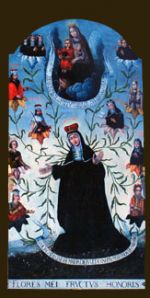 The picture is signed with the words: FLORES MEI FRUCTUS HONORTUS ('My flowers are fruit of fame'). Bridget is kneeling frontally, plant twigs are growing out of her breast with unwound calixes of the lily at the end. In these flowers there are half-length images of people, which are signed with the names: CAROLUS, BIRGERUS, BENEDICT, GVDMARVS, MERITA, ST. CATHARINA, INGEBVRGIS, CAECILIA. These are the names of her sons and daughters. In the highest two flowers we can see two groups of people.
The picture is signed with the words: FLORES MEI FRUCTUS HONORTUS ('My flowers are fruit of fame'). Bridget is kneeling frontally, plant twigs are growing out of her breast with unwound calixes of the lily at the end. In these flowers there are half-length images of people, which are signed with the names: CAROLUS, BIRGERUS, BENEDICT, GVDMARVS, MERITA, ST. CATHARINA, INGEBVRGIS, CAECILIA. These are the names of her sons and daughters. In the highest two flowers we can see two groups of people.
These are nuns and monks of the Bridget Order. The figures of children are composed without the chronology of seniority, at a similar distance from their mother. Only nuns and monks are shown at the height of the triumphing Mary and Christ. With their hands folded to prayer they are looking at the Mother of God, while Bridget's children are looking ahead. Only St. Catherine is holding a book in her hand, and Birgerus in one hand a sword, and in the second a rosary.
Bridget's figure assumed the form of a trunk, which roots are firmly rooted into the Earth. The arrangement of her hands in the orant gesture seems to form a unity with the twigs that grow out of her breast. Such an image can be found in one of the vision of the Saint, where Bridget is compared to the vine matrix, meaning the founder of a new order, from whom the useful branches will grow out. The caption also says: FLORES MEI FRUCTUS HONORIS.
This image is supplemented by another inscription, placed on the banderole held by Christ: HANC RELIGION AD HONOR MATRIS MEAE PER MULIERES PRIMUM ET PRINCIPALITER STATUERE VOLO ('I want to establish this convent in honour of my Mother, to be the first major among women'). Mary accepts this gift and promises this Order, dedicated to Her by Her Son, to defend it with a peculiar grace and to fill it with a bless of the Holy Spirit.
- Details
- Category: Pictorial cycle showing the passages of St. Bridget's (Swedish) life
 This is one of the two narrowest images that are currently in the benches of aisles. It shows St. Bridget, who was ordered to go to Rome. In the picture she is already on her way to the Eternal City. She is holding a pilgrim's cane and a cross, which she always had during her numerous pilgrimages. According to her biographers, she stared at the cross during the mind prayer. In this image, however, she is looking into heaven where Jesus is showing to her in the clouds. An inscription streching between the Christ and the Saint is complementing the image: D[OMINI] 1349 VT IN EXTRAVAGANTI CAP [ITE vel ITVLO] (from the command of Christ she is heading for Rome, of Anno Domini 1349, as [it is given]).
This is one of the two narrowest images that are currently in the benches of aisles. It shows St. Bridget, who was ordered to go to Rome. In the picture she is already on her way to the Eternal City. She is holding a pilgrim's cane and a cross, which she always had during her numerous pilgrimages. According to her biographers, she stared at the cross during the mind prayer. In this image, however, she is looking into heaven where Jesus is showing to her in the clouds. An inscription streching between the Christ and the Saint is complementing the image: D[OMINI] 1349 VT IN EXTRAVAGANTI CAP [ITE vel ITVLO] (from the command of Christ she is heading for Rome, of Anno Domini 1349, as [it is given]).
The Christ indeed sent Bridget to Rome to receive approval from the Pope of the rule of the new order she had prepared in Alwastra monastery. In addition, she wanted to receive an anniversary jubilee, which Pope Clement VI announced in 1350. She also wanted to influence the Pope to return for the good of Church from Avignon.
The pilgrimage, i.e. lonely travelling along the road, was at that time regarded as the image of the monk's life, a kind of exile, the state of strangeness on earth in the literal sense. The convent was a symbol of the inner desert, and the exodus was the commandment to leave oneself, to leave selfishness with the awareness of the insignificance of earthly existence. In the context of the entire cycle, this image belongs to a group of paintings, depicting the second stage of the Saint's life, which she led similar to monastic.






